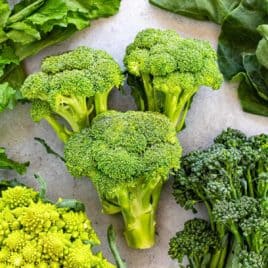Kale is a superfood based on merit, so don’t let this vegetable slip by. Incorporating different types of kale into your recipes not only enhances the nutritional value but also adds a delightful complexity to the flavors of your cooking.

You either love kale or hate it. And if you hate, it’s probably because you got a taste of its bitter, earthy flavor — or someone told you about it — and you’ve steered clear ever since. No doubt, it’s easy to be turned off by kale, but with some special prep and handling, it becomes a whole new vegetable.
It’s green and leafy, so you know it’s good for you. It belongs to the same family as broccoli, cauliflower, and Brussels sprouts (all members of the cabbage family). And beyond flavor, it’s pretty and decorative, so it makes salads look extra fancy. Kale deserves a few chances before you decide to write it off for good.
Several popular types of kale:
Curly Kale

The most common type of kale is curly, wild, and vibrant green in color. As the name suggests, its edges are curly and wild. Trimming away the tough center stem makes it easier to chew, but it can be left on when braising or stewing the kale.
It can be eaten raw in salads, but massaging the leaves will help reduce the bitterness. They are great for soups and sauteed dishes like stir-fries.
Baby Kale

It is a less mature kale. It has a much more mild flavor and a tender texture, making it great for salads and smoothies. It’s not ideal for cooking because it wilts relatively quickly, which is why you’ll usually only find it in premade salad mixtures.
Tuscan Kale

Known also as Lacinato or Dinosaur kale for its bumpy reptilian-like texture. The dark green leaves are a bit flatter, longer, and more tamed than curly kale. It’s great to use for salads, soups, stews, and baked kale chips. When cooked, the leaves soften but keep their structure.
Red Kale

It is also called Russian red kale or scarlet kale. Its leaves and stems may have red hues, but don’t be surprised if you see it with green leaves. The exact color can vary. It can be prepped and cooked similarly to curly kale. It looks really pretty sauteed or in a soup or stew. It adds vibrant purple hues to salads.
Flowering Kale

Also known are ornamental kale. They come in heads at the store, similar to lettuce. They can come with pretty purple leaves with green tips or even white leaves. It’s best to use as a garnish to make your dishes and charcuterie boards pop, or as a pretty centerpiece for a gathering.
How to Cook Kale

Kale is hearty and thick, so it can stand its ground in soups and stews like this Instant Pot Zuppa Toscana. But its hearty texture is also what can make it an unwelcome guest in salads.
The secret when learning how to cook kale is to massage and crunch the leaves with your hands before adding them to salads or eating it raw. Make sure to thoroughly rinse and dry the leaves after massaging. This tames the bitterness and texture.
A dressing with lemon juice or apple cider vinegar can also complement the bold flavor of kale. There are different ways to cook kale, like sauteing, steaming, and baking; make sure to give them a try!
Popular Kale Recipes
Kale Benefits
Let’s talk about antioxidants. Kale is famous for them, containing high amounts of hydroxycinnamic acid as well as flavonoids like quercetin and kaempferol. These are fancy words that basically mean kale possesses anti-inflammatory benefits, it’s linked to good heart health, and it may help prevent cancer.
In addition to having lots of antioxidants, kale is rich in beta-carotene (which your body converts to vitamin A) and vitamin C. It’s also a great source of vitamin K, which contributes to healthy bones.
Hungry for More?
Ingredient Guides
25 Types of Peppers to Know
Ingredient Guides
Types of Broccoli
Pantry Staples
22 Types of Cooking Oils and Fats
Pantry Staples












Laura says
Hi Jessica:
I just want to take the time to thank you for your awesome recipes you keep health and good taste in mind in creating all your tasteful recipes. I would love to thank you for your forward thinking tips and suggestions in keeping health the focal point.
Jessica Gavin says
You are so welcome Laura! I am happy to help you with recipes and nutrition of food.